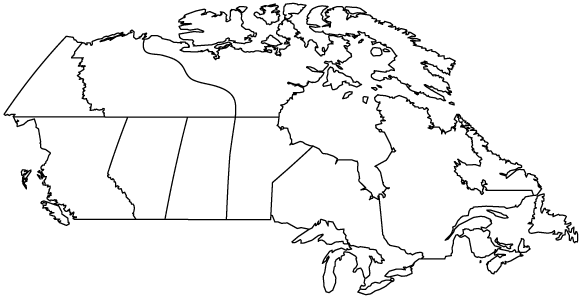 About Canada
About Canada
Brief History
 John Cabot (c. 1450 – c. 1498) of England was the first person to have discovered Canada’s Atlantic coast in 1497. Aboriginal people inhabited and occupied the land for millennia before the British and French settled here. Centuries later, following several constitutional conferences, the Constitution Act, 1867 brought about Confederation creating “one Dominion under the name of Canada” on July 1, 1867, with four provinces: Ontario, Quebec, Nova Scotia, and New Brunswick. Canada assumed control of Rupert’s Land and the North-Western Territory to form the Northwest Territories, where the Métis’ grievances ignited the Red River Rebellion and the creation of the province of Manitoba in July 1870. British Columbia and Vancouver Island (which had united in 1866) and the colony of Prince Edward Island joined the Confederation in 1871 and 1873, respectively.
John Cabot (c. 1450 – c. 1498) of England was the first person to have discovered Canada’s Atlantic coast in 1497. Aboriginal people inhabited and occupied the land for millennia before the British and French settled here. Centuries later, following several constitutional conferences, the Constitution Act, 1867 brought about Confederation creating “one Dominion under the name of Canada” on July 1, 1867, with four provinces: Ontario, Quebec, Nova Scotia, and New Brunswick. Canada assumed control of Rupert’s Land and the North-Western Territory to form the Northwest Territories, where the Métis’ grievances ignited the Red River Rebellion and the creation of the province of Manitoba in July 1870. British Columbia and Vancouver Island (which had united in 1866) and the colony of Prince Edward Island joined the Confederation in 1871 and 1873, respectively.
“Canada” comes from a St. Lawrence Iroquoian word, kanata, meaning “village” or “settlement”.
Today, Canada is a federation composed of ten provinces and three territories; in turn, these may be grouped into regions. Western Canada consists of British Columbia and the three Prairie provinces (Alberta, Saskatchewan, and Manitoba). Central Canada consists of Quebec and Ontario. Atlantic Canada consists of the three Maritime provinces (New Brunswick, Prince Edward Island, and Nova Scotia), along with Newfoundland and Labrador. Eastern Canada refers to Central Canada and Atlantic Canada together. Three territories (Yukon, Northwest Territories, and Nunavut) make up Northern Canada.
Government:
Canada has a parliamentary government with strong democratic traditions. The Parliament is made up of the Crown, an elected House of Commons, and an appointed Senate. Each Member of Parliament in the House of Commons is elected by simple plurality in an electoral district or riding. General elections must be called by the prime minister within five years of the previous election, or may be triggered by the government’s losing a confidence vote in the House.
Canada is also a constitutional monarchy, with The Crown acting as a symbolic or ceremonial executive. The Crown consists of Queen Elizabeth II (legal head of state).
Canada currently employs a professional, volunteer military force of about 65,000 regular and 25,000 reserve personnel. The unified Canadian Forces (CF) comprise the army, navy, and air force.
Health Care:
Canada delivers a federally sponsored, publicly funded health care system known as the ‘Medicare’ system, with most services provided by the private sector. It is guided by the provisions of the Canada Health Act.
The various levels of government pay for about 70% of Canadians’ health care.
About 30% of Canadians’ health care is paid for through the private sector. This mostly goes towards services not covered or only partially covered by Medicare, such as prescription drugs, dentistry and optometry. Some 65% of Canadians have some form of supplementary private health insurance, many of whom receive it through their employers.
Each province regulates its medical profession through a self-governing College of Physicians and Surgeons, which is responsible for licensing physicians, setting practice standards, professional development and evaluation.
The national doctors association is called the Canadian Medical Association. Because health care is deemed to be under provincial/territorial jurisdiction, negotiations on behalf of physicians are conducted by provincial associations such as the Ontario Medical Association.
Demographics:
The 2011 Canadian census counted a total population of 33,476,688. The largest ethnic group is English (21%), followed by French (15.8%), Scottish (15.2%), Irish (13.9%), German (10.2%), Italian (5%), Chinese (4%), Ukrainian (3.6%), and First Nations (3.5%). The largest visible minority groups in Canada are South Asian (4.1%), Chinese (4%) and Black (2.5%).
Canada has the highest per-capita immigration rate in the world, driven by economic policy and family reunification, and is aiming for between 240,000 and 265,000 new permanent residents in 2010. Canada also accepts large numbers of refugees. New immigrants settle mostly in major urban areas like Toronto and Vancouver.
In common with many other developed countries, Canada is experiencing a demographic shift towards an older population, with more retirees and fewer people of working age. In 2006, the average age of the population was 39.5 years. The census results also indicate that despite an increase in immigration since 2001 (which gave Canada a higher rate of population growth than in the previous intercensal period), the aging of Canada’s population did not slow during the period.
Support for religious pluralism is an important part of Canada’s political culture. According to the 2001 census, 77.1% of Canadians identify as being Christians; of this, Catholics make up the largest group (43.6% of Canadians). The largest Protestant denomination is the United Church of Canada (9.5% of Canadians), followed by the Anglicans (6.8%), Baptists (2.4%), Lutherans (2%), and other Christians (4.4%). About 16.5% of Canadians declare no religious affiliation, and the remaining 6.3% are affiliated with non-Christian religions, the largest of which is Islam (2.0%), followed by Judaism (1.1%).